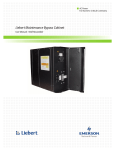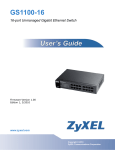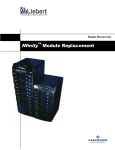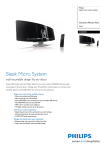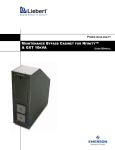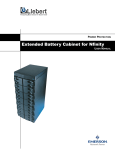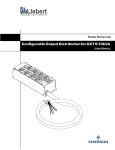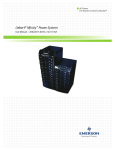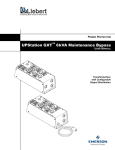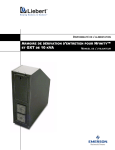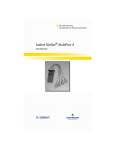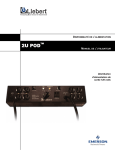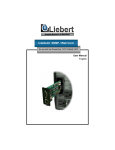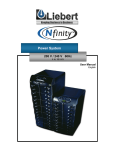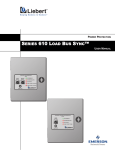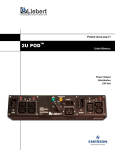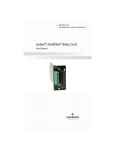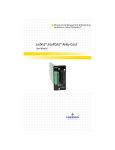Download User Manual - appind.com
Transcript
POWER PROTECTION MAINTENANCE BYPASS CABINET USER MANUAL Wall-Mountable TABLE OF CONTENTS IMPORTANT SAFETY INSTRUCTIONS . . . . . . . . . . . . . . . . . . . . . . . . . . . . . . . . . . . . . . . . . . . . . . . .1 GLOSSARY OF SYMBOLS . . . . . . . . . . . . . . . . . . . . . . . . . . . . . . . . . . . . . . . . . . . . . . . . . . . . . . . .2 1.0 GENERAL DESCRIPTION . . . . . . . . . . . . . . . . . . . . . . . . . . . . . . . . . . . . . . . . . . . . . . . . . . .3 1.1 System Description. . . . . . . . . . . . . . . . . . . . . . . . . . . . . . . . . . . . . . . . . . . . . . . . . . . . . . . . . . . 3 1.2 Features . . . . . . . . . . . . . . . . . . . . . . . . . . . . . . . . . . . . . . . . . . . . . . . . . . . . . . . . . . . . . . . . . . . 3 1.3 Standard Components . . . . . . . . . . . . . . . . . . . . . . . . . . . . . . . . . . . . . . . . . . . . . . . . . . . . . . . . 3 2.0 MODES OF OPERATION . . . . . . . . . . . . . . . . . . . . . . . . . . . . . . . . . . . . . . . . . . . . . . . . . . . .5 2.1 Bypass Switch. . . . . . . . . . . . . . . . . . . . . . . . . . . . . . . . . . . . . . . . . . . . . . . . . . . . . . . . . . . . . . . 5 2.2 UPS Mode . . . . . . . . . . . . . . . . . . . . . . . . . . . . . . . . . . . . . . . . . . . . . . . . . . . . . . . . . . . . . . . . . . 5 2.3 Bypass Mode . . . . . . . . . . . . . . . . . . . . . . . . . . . . . . . . . . . . . . . . . . . . . . . . . . . . . . . . . . . . . . . . 6 3.0 PREPARATION . . . . . . . . . . . . . . . . . . . . . . . . . . . . . . . . . . . . . . . . . . . . . . . . . . . . . . . . . .7 3.1 Inspection . . . . . . . . . . . . . . . . . . . . . . . . . . . . . . . . . . . . . . . . . . . . . . . . . . . . . . . . . . . . . . . . . . 7 3.2 Environment . . . . . . . . . . . . . . . . . . . . . . . . . . . . . . . . . . . . . . . . . . . . . . . . . . . . . . . . . . . . . . . . 7 3.3 Required Setup Equipment . . . . . . . . . . . . . . . . . . . . . . . . . . . . . . . . . . . . . . . . . . . . . . . . . . . . 7 3.4 Site Preparation . . . . . . . . . . . . . . . . . . . . . . . . . . . . . . . . . . . . . . . . . . . . . . . . . . . . . . . . . . . . . 7 3.5 Mounting the Cabinet . . . . . . . . . . . . . . . . . . . . . . . . . . . . . . . . . . . . . . . . . . . . . . . . . . . . . . . . 8 4.0 CABLE INSTALLATION . . . . . . . . . . . . . . . . . . . . . . . . . . . . . . . . . . . . . . . . . . . . . . . . . . . . .9 4.1 Wiring Preparation. . . . . . . . . . . . . . . . . . . . . . . . . . . . . . . . . . . . . . . . . . . . . . . . . . . . . . . . . . . 9 4.1.1 4.2 Dual Source Configuration . . . . . . . . . . . . . . . . . . . . . . . . . . . . . . . . . . . . . . . . . . . . . . . . . . . . 9 4.2.1 4.3 Preparing Internal Wiring . . . . . . . . . . . . . . . . . . . . . . . . . . . . . . . . . . . . . . . . . . . . . . . . . . . . . . 9 Removing the Cover Plates . . . . . . . . . . . . . . . . . . . . . . . . . . . . . . . . . . . . . . . . . . . . . . . . . . . . 10 Power Cable Installation . . . . . . . . . . . . . . . . . . . . . . . . . . . . . . . . . . . . . . . . . . . . . . . . . . . . . 10 4.3.1 4.3.2 Input/Output Wiring (TB1) . . . . . . . . . . . . . . . . . . . . . . . . . . . . . . . . . . . . . . . . . . . . . . . . . . . . 11 Connection to GXT10000T . . . . . . . . . . . . . . . . . . . . . . . . . . . . . . . . . . . . . . . . . . . . . . . . . . . . . 11 5.0 OPERATING PROCEDURES . . . . . . . . . . . . . . . . . . . . . . . . . . . . . . . . . . . . . . . . . . . . . . . . 15 5.1 Start-Up and Initialization . . . . . . . . . . . . . . . . . . . . . . . . . . . . . . . . . . . . . . . . . . . . . . . . . . . 15 5.2 Shutting Down the UPS. . . . . . . . . . . . . . . . . . . . . . . . . . . . . . . . . . . . . . . . . . . . . . . . . . . . . . 15 5.3 Transferring System from UPS to Maintenance Bypass Operation . . . . . . . . . . . . . . . . . . . 15 5.4 Transfer of the System from Maintenance Bypass to UPS Operation . . . . . . . . . . . . . . . . . 15 6.0 MAINTENANCE . . . . . . . . . . . . . . . . . . . . . . . . . . . . . . . . . . . . . . . . . . . . . . . . . . . . . . . . . 16 6.1 Proper Care. . . . . . . . . . . . . . . . . . . . . . . . . . . . . . . . . . . . . . . . . . . . . . . . . . . . . . . . . . . . . . . . 16 7.0 SPECIFICATIONS . . . . . . . . . . . . . . . . . . . . . . . . . . . . . . . . . . . . . . . . . . . . . . . . . . . . . . . .17 i FIGURES Figure 1 Figure 2 Figure 3 Figure 4 Figure 5 Figure 6 Figure 7 Figure 8 Figure 9 Figure 10 Figure 11 Front view . . . . . . . . . . . . . . . . . . . . . . . . . . . . . . . . . . . . . . . . . . . . . . . . . . . . . . . . . . . . . . . . . . . . . . 4 Rear view . . . . . . . . . . . . . . . . . . . . . . . . . . . . . . . . . . . . . . . . . . . . . . . . . . . . . . . . . . . . . . . . . . . . . . . 4 Maintenance Bypass Cabinet in UPS Mode . . . . . . . . . . . . . . . . . . . . . . . . . . . . . . . . . . . . . . . . . . . 5 Maintenance Bypass Cabinet in Bypass Mode . . . . . . . . . . . . . . . . . . . . . . . . . . . . . . . . . . . . . . . . . 6 Wall-mount dimensions . . . . . . . . . . . . . . . . . . . . . . . . . . . . . . . . . . . . . . . . . . . . . . . . . . . . . . . . . . . 8 Wiring for dual sources. . . . . . . . . . . . . . . . . . . . . . . . . . . . . . . . . . . . . . . . . . . . . . . . . . . . . . . . . . . . 9 Cover plate removal . . . . . . . . . . . . . . . . . . . . . . . . . . . . . . . . . . . . . . . . . . . . . . . . . . . . . . . . . . . . . 10 Connecting Maintenance Bypass to GXT10000T-208X . . . . . . . . . . . . . . . . . . . . . . . . . . . . . . . . . 12 Connecting Maintenance Bypass to GXT10000T-240X . . . . . . . . . . . . . . . . . . . . . . . . . . . . . . . . . 12 Maintenance Bypass Cabinet . . . . . . . . . . . . . . . . . . . . . . . . . . . . . . . . . . . . . . . . . . . . . . . . . . . . . 13 Connecting Nfinity to Maintenance Bypass . . . . . . . . . . . . . . . . . . . . . . . . . . . . . . . . . . . . . . . . . . 14 TABLES Table 1 Table 2 Table 3 Dimensional data . . . . . . . . . . . . . . . . . . . . . . . . . . . . . . . . . . . . . . . . . . . . . . . . . . . . . . . . . . . . . . . . 7 Nfinity power cable and protection ratings . . . . . . . . . . . . . . . . . . . . . . . . . . . . . . . . . . . . . . . . . . . 10 GXT 10kVA power cable and protection ratings . . . . . . . . . . . . . . . . . . . . . . . . . . . . . . . . . . . . . . . 11 ii IMPORTANT SAFETY INSTRUCTIONS SAVE THESE INSTRUCTIONS This manual contains important instructions that should be closely followed during installation and maintenance of this wall-mountable Maintenance Bypass Cabinet. This product is designed for commercial/industrial use only. This product is not intended for use with life support and other designated “critical” devices. Maximum load must not exceed that shown on the UPS and the Maintenance Bypass Cabinet rating label. ! WARNING Lethal voltages may be present within this unit even when it is apparently not operating. Observe all cautions and warnings in this manual. Failure to do so may result in serious injury or death. Never work alone. The Maintenance Bypass Cabinet is designed for use on properly grounded (earthed) 208/240 VAC, 50 or 60Hz supply, for installation by qualified personnel. This UPS equipment is intended to be installed by a qualified / certified electrician who must review and approve customer supplied wiring, circuit breakers, intended loads and verify correct input, output and grounded (earthed) connections to ensure compliance with technical standards and national and local electrical codes. Installation instructions and warning notices are located in 4.0 - Cable Installation. ! CAUTION To reduce the risk of fire: The NMBHW4x model must be connected to a circuit provided with 100A maximum branch circuit overcurrent protection in accordance with applicable national and local electrical codes. The NMBHW8x model must be connected to a circuit provided with 125A maximum branch circuit overcurrent protection in accordance with applicable national and local electrical codes. Operate the UPS equipment in an indoor environment only in an ambient temperature range of 32°F to 104°F (0°C to 40°C). Install it in a clean environment, free from conductive contaminants, moisture, flammable liquids, gases, or corrosive substances. Never block or insert any object into the ventilation holes or other openings. 1 GLOSSARY OF SYMBOLS Risk of Electrical Shock Indicates Warning or Caution Followed by Important Instructions AC Input AC Output i Requests the user to consult the manual Equipment Grounding Conductor ON OFF 2 General Description 1.0 GENERAL DESCRIPTION Congratulations on your purchase of Liebert’s wall-mountable Maintenance Bypass Cabinet. As with every Liebert product, we stand behind our quality. If you have any questions concerning this wallmountable Maintenance Bypass Cabinet, please feel free to contact your local dealer, Liebert representative, or call the appropriate Technical Support number listed on the back of this manual. To ensure proper installation and operation of this unit, please read this manual thoroughly. Installation must be done by a qualified/certified electrician, but general operation may be performed without special training. 1.1 System Description This wall-mountable Maintenance Bypass Cabinet is intended for use with the Nfinity, UPStation GXT 6&10 kVA, or any other UPS with equivalent specifications. Typical applications include supporting workstations, servers, network, telecom or other sensitive electronic equipment. The Maintenance Bypass Cabinet was designed to provide maximum system availability to business critical equipment. The Maintenance Bypass Cabinet allows for transfer of connected loads to an alternate power path allowing full isolation of the UPS. The UPS can then be turned “OFF” and removed from service with no interruption of power to connected loads. 1.2 Features • • • • 1.3 Supports up to 20 kVA loads High speed transfer switch Compact design Multiple power path indicators Standard Components • Easily accessible terminal blocks • Wall-mountable • Dual-source compatible for increased availability 3 General Description Figure 1 Front view Bypass Mode Indicator Lamp UPS Mode Indicator Lamp Lockout/Tagout Door SW1 CB1 SW2 Figure 2 Rear view End cover plate (removable for internal inspection) TB6 Slot for wall-mount arrangement (one of four) End plate (remove during cable installation) Knockout for cable entrance (one of five) Grounding lug 4 Modes of Operation 2.0 MODES OF OPERATION The Maintenance Bypass Cabinet is designed to operate in UPS mode and Bypass mode. The mode is selected using the Bypass Switch. 2.1 Bypass Switch The Bypass Switch allows easy and rapid transfer of connected loads between the UPS and Bypass source. 2.2 UPS Mode While the Maintenance Bypass Cabinet is in the UPS Mode, the UPS is supplying the connected load with continuous high quality AC power. In this mode of operation, the load is protected by the UPS. The Bypass Switch rotated toward the green lamp indicates this mode. Figure 3 Maintenance Bypass Cabinet in UPS Mode UPS output available (green) 5 Modes of Operation 2.3 Bypass Mode When the Maintenance Bypass Cabinet is in the Bypass mode it provides an alternate path for power to the connected equipment. Should the UPS need to be taken out of service for limited maintenance or repair, manual activation of the bypass will cause an immediate transfer of the equipment from the UPS inverter to the bypass source. The amber lamp illuminated in the Maintenance Bypass Switch compartment indicates bypass is available. In this mode of operation the load is NOT protected by the UPS. The Bypass Switch rotated toward the amber lamp indicates this mode. See 5.0 - Operating Procedures for instructions on use. Figure 4 Maintenance Bypass Cabinet in Bypass Mode Bypass available (amber) UPS Input Source (amber) ON = AC power supplied to UPS input OFF = AC power removed from UPS input 6 Preparation 3.0 PREPARATION These installation instructions provide all the information needed for positioning the Maintenance Bypass Cabinet (including environmental requirements) and for connecting the input and output power cables. 3.1 Inspection Upon receiving the Maintenance Bypass Cabinet, examine the packaging for any signs of mishandling or damage. If any damage is noted, contact your local dealer or Liebert representative and notify your carrier. 3.2 Environment The Maintenance Bypass Cabinet environment must be free of conductive contaminants and excessive moisture (water condensation), flammable vapors, chemical fumes, or corrosive gases and liquids. 3.3 Required Setup Equipment The tools below are required in order to properly set up your Maintenance Bypass Cabinet: • • • • 3.4 torque wrench flat-head screwdriver 3/16" (5 mm) Allen wrench T-20 Torx driver Site Preparation When deciding where to locate your Maintenance Bypass Cabinet, consider the weight and size of the unit. Make sure that the structural integrity of the wall can withstand the weight. Refer to the table below for dimensional considerations: Table 1 Dimensional data Model WxDxH In (mm) Weight lbs, (kg) NMBHWxx 20 x 8 x 18 (508 x 203 x 457) 45 (20.5) 7 Preparation 3.5 Mounting the Cabinet This Maintenance Bypass Cabinet may be placed on the floor or mounted on a wall. In both cases, ensure that the unit is in a well-ventilated area with at least 12 inches (305 mm) clearance for access to the switches and cable connections. When placing the cabinet on the floor, install the four rubber feet provided with the unit. One rubber foot goes on each corner of the the unit on the side where keyhole slots have been cut. If the Maintenance Bypass Cabinet is to be mounted on a wall, you must install hardware to support the unit. Depending on the type of wall, you may need to install special anchors. The Maintenance Bypass Cabinet has four keyhole-shaped slots to support it when mounted on a wall. To mount the unit: 1. Mark the wall where you will install the mounting hardware, either screws, anchors or bolts strong enough to support the unit (see Wall-mount dimensions on page 8 for layout dimensions). 2. Insert the mounting screws, anchors or bolts, leaving enough clearance between the bolt heads and the wall to accommodate the Maintenance Bypass Cabinet’s metal case. 3. Tighten the mounting bolts until they are snug, holding the Maintenance Bypass Cabinet firmly against the wall. Figure 5 Wall-mount dimensions 20" (508mm) 1/2" (12.7mm) 19" (482.6mm) 18" (457.2mm) 14" (355.6mm) 2" (50.8mm) 8 0.281" 1/4" (6.35mm) hardware Cable Installation 4.0 CABLE INSTALLATION 4.1 Wiring Preparation ! WARNING Please read this section thoroughly before attempting to install wiring to this unit. Be sure that the unit is not connected to any AC mains power source or UPS before installing any wiring to this unit. This Maintenance Bypass Cabinet should be installed by a qualified / certified electrician. 4.1.1 Preparing Internal Wiring The Maintenance Bypass Cabinet is factory-configured for single-source installations. If your installation requires dual-source capabilities, the Maintenance Bypass Cabinet’s wiring must be modified. 4.2 Dual Source Configuration Modifying the wiring consists of removing the jumpers between TB1 and TB2 as described below: 1. 2. 3. 4. 5. Figure 6 Remove cover plates. Identify TB1 and TB2. Using a 3/16" Allen wrench, loosen terminal mounting jumpers between TB1 and TB2. Remove jumpers and retighten terminals to 22-26 in-lb (2.5 to 3.0 Nm). Connect primary source to TB2 and secondary source to TB1. Wiring modifications for dual inputs FRONT VIEW TB2 SIDE VIEW TB2 Remove these three cables TB1 TB1 9 Cable Installation 4.2.1 Removing the Cover Plates Plates cover the input and output terminals on the back of the Maintenance Bypass Cabinet (see illustration below). Remove these using a T-20 Torx screwdriver. Keep screws and plates to one side. Figure 7 Cover plate removal Remove these screws to open end plate and cover plate. This screw and a second screw underneath unit serve as hinges to open end plate. Remove these screws to open end plate and cover plate (fourth screw is underneath unit). 4.3 Power Cable Installation Refer to Table 2 when selecting cables: Table 2 Nfinity power cable and protection ratings Model NMBHW4x Max Input Current 100 A Input Protection 100 A Max Output Current 100 A Input/ Output Terminal Details Max: 2/0 (70 mm2) Min: 6 AWG (16 mm2) Model NMBHW8x Max Input Current 125 A Input Protection 125 A Max Output Current 125 A Input/ Output Terminal Details Max: 2/0 (70 mm2) Min: 6 AWG (16 mm2) NOTE Transient and steady state earth leakage currents may occur when starting the equipment. This should be taken into account when selecting ground current detection devices, as these will carry the earth leakage currents of both the UPS equipment and the load. 10 Cable Installation 4.3.1 Input/Output Wiring (TB1) Follow the steps below to connect the input wiring: NOTE Input wiring must be installed using conduit. 208 input voltage jumper—if only the connections for 208 VAC are made between the UPS and the Maintenance Bypass, the 208 input voltage jumper must be installed for proper operation. To install this jumper, place the jumper wire provided in the accessory kit between Pin 1 and Pin 2 on TB4. 1. Locate the input wiring access, remove the knockout and pull the three/four input wires through it, allowing some slack for installation. 2. Secure the conduit to the rear panel of the Maintenance Bypass Cabinet. 3. Input power cables connect to hex terminals on the input terminal block. 4. Insert the ground (earth) wire through the earth lug and tighten it to the proper torque value (2226 in-lb). Then connect the wires to the block connections as shown below. Using a torque wrench, turn the screws clockwise until tightened to the proper torque value (22-26 in-lb). 4.3.2 Connection to GXT10000T Wiring Preparation ! WARNING Please read these instructions thoroughly before attempting to connect any wiring to this unit. Ensure that the unit is not connected to any AC utility power source or UPS before connecting any wiring to this unit. Wiring connections should be performed only by a qualified/certified electrician. Power Cable Installation Refer to Table 3 and subsequent illustrations when selecting cables. Table 3 GXT 10kVA power cable and protection ratings Max Input Current 208V 240V 45A 44A Input Protection 60A 60A Max Output Current 43A 42A Terminal Block Details Max: 35 mm2 (2/0 AWG) Min: 16 mm2 (6 AWG) NOTE Transient and steady state earth leakage currents may occur when starting the equipment. This should be taken into account when selecting ground current detection devices, as these will carry the earth leakage currents of both the UPS equipment and the load. 11 Cable Installation Figure 8 Connecting Maintenance Bypass to GXT10000T-208X 120V Incoming L2 NFINITY MAINTENANCE BYPASS CABINET TB5 1 WITHOUT TRANSFORMER TB2 L1 INPUT 2 Incoming L1 L2 2 N 3 INPUT 1 G G L2 Incoming L1 Caution 208V 4 G TB1 L1 Incoming L2 120V N TB3 G L1 L2 G TB4 It is mandatory to connect inputs exactly as shown. G 1 2 3 4 GEC L1 L2 N Input L1 L2 L2A Output External Battery GXT10000T-208X Figure 9 Connecting Maintenance Bypass to GXT10000T-240X TB2 INPUT 2 INPUT 1 L1 NFINITY MAINTENANCE BYPASS CABINET TB5 1 WITHOUT TRANSFORMER L2 2 N 3 120V 240V 4 G TB1 L1 G G L2 N TB3 G L1 L2 G TB4 G 1 2 3 4 GEC L1 L2 Input N L1 Output L2 External Battery GXT10000T-240X NOTES 1. SINGLE-SOURCE FEED—If feeding the Maintenance Bypass Cabinet from a single source, the input connection may be made to either TB1 or TB2. 2. DUAL-SOURCE FEED—If feeding the Maintenance Bypass Cabinet from a dual source, the UPS input supply connection must be made to TB1 and the bypass input supply connection must be made to TB2. The link between TB1 and TB2 must be removed. 12 Cable Installation Figure 10 Maintenance Bypass Cabinet Input 2 TB5 TB2 Single input jumper (remove for dual input feeds) TB1 Input 1 SW2 UPS Input Switch CB1 Output Breaker SW1 Bypass Switch TB3 UPS Input SW1 Bypass Switch TB6 N/C C N/0 13 TB4 UPS Output Output Cable Installation Figure 11 Connecting Nfinity to Maintenance Bypass TB2 TB5 L1 Input 2 120 120 208 240 1 2 3 MAINTENANCE BYPASS CABINET L2 N 4 Remove these three wires for dual source G TB1 Input 1 G L1 G L2 N G TB6 G TB3 L1 L2 G 1 TB4 2 3 4 NO Common NC Flexible conduit L1 L2 G 1 2 3 TB1 TB2 Ensure that the tap selector is set to the correct input voltage 1 2 3 4 5 TB3 GEC See the user manual for your UPS for details on connecting GEC. UPS NOTE 1. If feeding the Maintenance Bypass Cabinet from a single source, the input connection may be made to either TB1 or TB2. 2. If feeding the Maintenance Bypass Cabinet from a dual source, the UPS input supply connection must be made to TB1 and the bypass input supply connection must be made to TB2. The link between TB1 and TB2 must be removed. 3. TB6 provides Normally Open and Normally Closed contacts to indicate operation of the bypass switch. Maintenance Bypass Switch Position TB6 Contacts Bypass NO - Common: Open NC - Common: Closed UPS NO - Common: Closed NC - Common: Open 14 Operating Procedures 5.0 OPERATING PROCEDURES 5.1 Start-Up and Initialization Follow these steps to start up the UPS while connected to the Maintenance Bypass. 1. 2. 3. 4. 5. 6. 5.2 Set Maintenance Bypass switch (SW1) to UPS position on Maintenance Bypass Cabinet. Close UPS source switch (SW2). Close output circuit breaker (CB1). Close input circuit breaker (CB1). On UPS, close control enable switch (SW2). After UPS has initialized, turn UPS output on by pushing the standby button. Shutting Down the UPS Use the following procedure to power down the system. 1. 2. 3. 4. 5. 5.3 Turn UPS output off by pushing the Standby button. Open the control enable switch (SW2) on the UPS. Open the input circuit breaker (CB1) on the UPS. Open the UPS source switch (SW1) on the Maintenance Bypass Cabinet. Open the output circuit breaker (CB1) on the Maintenance Bypass Cabinet. Transferring System from UPS to Maintenance Bypass Operation 1. Verify that the amber bypass lamp is illuminated 2. Turn the bypass switch (SW1) to the bypass position on the Maintenance Bypass Cabinet. The connected equipment is now powered from the bypass source and is not protected. 5.4 Transfer of the System from Maintenance Bypass to UPS Operation 1. 2. 3. 4. Close the UPS source switch (SW1) on the Maintenance Bypass Cabinet. Close the input circuit breaker (CB1) on the UPS. Close the control enable switch (SW2) on the UPS. Turn the UPS output on by pushing the standby button on the UPS. Verify the Green UPS lamp is illuminated. 5. Turn the bypass switch to the bypass position on the Maintenance Bypass Cabinet. 15 Maintenance 6.0 MAINTENANCE 6.1 Proper Care Keeping your Liebert Maintenance Bypass Cabinet operating properly is imperative to optimal performance and life of the unit. It is recommended that a certified technician perform preventive and corrective maintenance. Liebert Global Services (LGS) is dedicated to ensuring the highest level of performance and unmatched support for your Maintenance Bypass Cabinet. Contact an LGS representative for services to guarantee maximum reliability and system availability. 16 Specifications 7.0 SPECIFICATIONS General & Environmental NMBHW4x = 16kVA NMBHW8x = 20kVA Unit Rating NMBHW4x = 100A max NMBHW8x = 125A max Compliant Safety Standards UL 1778, c-UL Mechanical Dimensions, WxDxH, in. (mm) 20 x 8 x 18 (508 x 203 x 457) Weight 45 lb. (20.5 kg) Environmental Operating Temperature, maximum 32° - 104°F (0° - 40°C) Relative Humidity 5 - 95% noncondensing Operating Altitude, maximum 10,000 ft.; (3,000m) Input Data Nominal Input Voltage 208 or 240VAC Input Frequency, nominal 50 or 60Hz Input Frequency Range Output Data Output Voltage, VAC 45-55Hz or 55-65Hz 208/240 240 208 120/120/208/240 120/120/240 120/120/208 Transfer Time <4 msec typical Output Frequency 50 or 60Hz (same as input) Maximum Voltage 120VAC Maximum Current 5A TB6 Contacts 17 Specifications 18 POWER PROTECTION Maintenance Bypass Cabinet USER MANUAL The Company Behind the Products With over a million installations around the globe, Liebert is the world leader in computer protection systems. Since its founding in 1965, Liebert has developed a complete range of support and protection systems for sensitive electronics: • • • • • Environmental systems—close-control air conditioning from 1 to 60 tons Power conditioning and UPS with power ranges from 300 VA to more than 1000 kVA Integrated systems that provide both environmental and power protection in a single, flexible package Monitoring and control—from systems of any size or location, on-site or remote Service and support through more than 100 service centers around the world and a 24/7 Customer Response Center While every precaution has been taken to ensure the accuracy and completeness of this literature, Liebert Corporation assumes no responsibility and disclaims all liability for damages resulting from use of this information or for any errors or omissions. © 2003 Liebert Corporation All rights reserved throughout the world. Specifications subject to change without notice. ® Liebert and the Liebert logo are registered trademarks of Liebert Corporation. All names referred to are trademarks or registered trademarks of their respective owners. SL-23967 (11/03) Rev. 1 Technical Support/Service Web Site www.liebert.com Monitoring 800-222-5877 [email protected] Outside the US: 614-841-6755 Single-Phase UPS 800-222-5877 [email protected] Outside the US: 614-841-6755 Three-Phase UPS 800-543-2378 [email protected] Environmental Systems 800-543-2778 Outside the United States 614-888-0246 Locations United States 1050 Dearborn Drive P.O. Box 29186 Columbus, OH 43229 Italy Via Leonardo Da Vinci 8 Zona Industriale Tognana 35028 Piove Di Sacco (PD) +39 049 9719 111 Fax: +39 049 5841 257 Asia 23F, Allied Kajima Bldg. 138 Gloucester Road Wanchai Hong Kong +852 2 572 2201 Fax: +852 2 831 0114
























